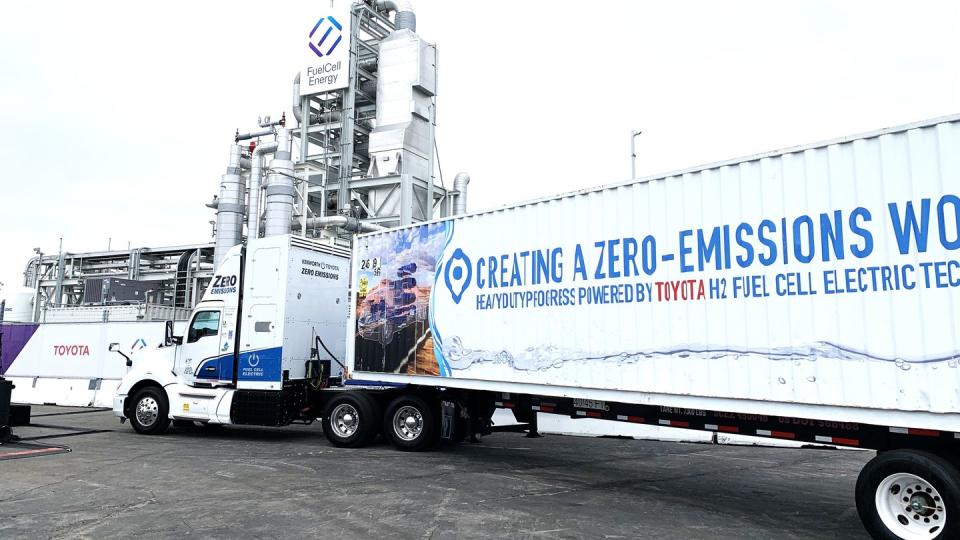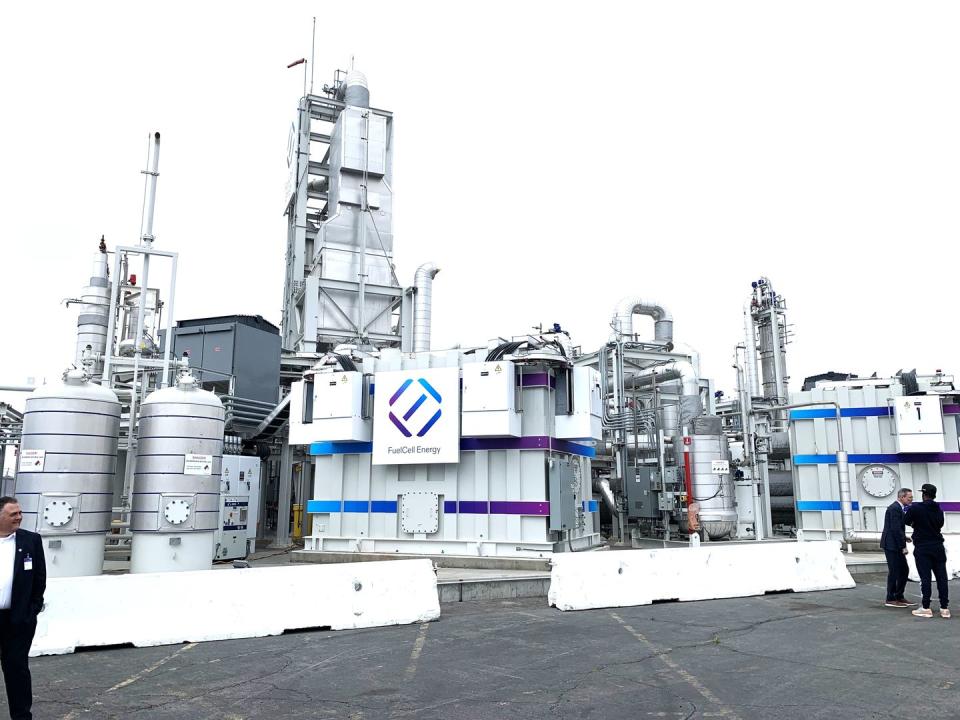Toyota and a Company Called Fuel Cell Energy Make Case for Hydrogen

Toyota and Fuel Cell Energy have partnered to create a mini refinery to produce hydrogen for Class 8 fuel-cell trucks and electricity to run its port operations. The facility even produces clean water to wash Toyotas coming off the ships.
The operation is expensive, in the tens of millions, but highly efficient.
Such facilities could be built at sewage treatment plants and landfills to convert deadly methane into useable hydrogen fuel.
Hydrogen certainly has its critics.
The Sierra Club calls it “an inefficient use of clean electricity,” and says, “Hydrogen should not be used to power most vehicles.” Issues in Science and Technology, a quarterly journal published by the National Academy of Sciences, notes that “A key problem with the hydrogen economy is that pollution-free sources of hydrogen are unlikely to be practical and affordable for decades.”
The International Energy Agency says 99% of globally produced hydrogen is made from fossil fuels. Elon Musk, the Great and Powerful, has called it “staggeringly dumb” when it’s used to fuel automobiles and doesn’t see it as a viable fuel for trucks. Even Toyota admits hydrogen is not as efficient as electricity when it comes to passenger cars. And I once wrote a column titled, “Hydrogen Is Bunk.”
But it’s inefficient because almost all of the hydrogen used in fuel-cell cars and in other applications right now comes from natural gas. Natural gas is plentiful and is even a byproduct of petroleum, coming as it does in pockets under the ground near goopy swimholes of crude oil.
To extract hydrogen from it, you perform a process called reformation of natural gas. That process is energy intensive and releases carbon dioxide into the atmosphere, which cancels the benefit of zero tailpipe emissions.
However, when you use biomass instead of natural gas, you’re ahead of the game. Biogas is the methane that burps up out of trash dumps, manure piles, and swamps. There are huge supplies of biogas right now all over the world that are just venting into the atmosphere.

And when methane goes up into the air, it is roughly 20 times more devastating than CO2 in destroying the ozone layer. Capture that stuff to make your natural gas and you’re on your way to a cleaner, greener Earth.
Which brings us back to Toyota, which seems to be sticking to hydrogen fuel cells when most other automakers have long since decided to switch to electric cars.
Toyota has partnered with a company called Fuel Cell Energy of Danbury, Connecticut, and built a new facility at its Long Beach, California, port operations. Fuel Cell Energy builds what you might call mini refineries to convert biomass—or natural gas—into hydrogen. The mini refineries take up about the space of a baseball diamond.
In addition to hydrogen, they produce electricity and pure water, all of which can be sold to pay for the refinery. Position these refineries around the world on top of biogas sources like sewage treatment plants and landfills, and you essentially have a free supply of hydrogen, electricity, and pure water while eliminating harmful release of methane into the atmosphere.
Toyota just opened one in the Port of Long Beach where it unloads its cars off of its ships. The hydrogen goes into a fleet of Class 8 semis that haul cars around Los Angeles, as well as into forklifts and dryage trucks used in the port. The electricity powers port operations, and Toyota uses the water produced to wash the cars.
The drawbacks? It costs “tens of millions of dollars” to put up the refinery. That cost amortizes out over the 20-year lifecycle of the refinery. A smaller setup costs less. Not all locations need to produce electricity and water, which likewise lowers costs.
The “clean biomass” for the Port of Long Beach refinery is purchased from a biomass facility in Victorville that puts it into the natural gas stream, but the actual gas used at the new plant is just pulled from the regular gas lines. Toyota purchases credits from the Victorville operation to offset the source material.
To be really effective, these plants would have to be everywhere, and biomass refining is limited now to locations with biomass. You couldn’t build a network that would help with the woefully inadequate fuel station network that owners of Toyota Mirais and other FCEVs are dealing with now.
But it’s still cleaner than simply reformulating natural gas to get hydrogen as is done today.
“Hydrogen is part of our future,” said Koji Sato, president of Toyota Motor Corporation.
Toyota’s hydrogen goals include everything from the humble Mirai to Class 8 big rigs and stationary power plants all run on clean hydrogen.
“We do not see a future without hydrogen,” said Jordan Choby, group vice president, powertrain for Toyota Motor North America, Research and Development.
Toyota also has plans for battery-electric vehicles, having just sunk $1.4 billion into batteries of its own.
“Toyota will prepare for assembly of an all-new, three row battery-electric SUV in the US as part of a new $1.4 billion investment in its Princeton (Indiana) facility,” the company said last month.
“This investment will not only provide plant infrastructure to build the all-new BEV, it will add a new battery pack assembly line using lithium-ion batteries supplied by Toyota Battery Manufacturing North Carolina, a $13.9 billion facility slated to begin production in 2025.”
But it’s the biomass-fueled refinery that seems the most interesting today. Considering the damage being done by escaped methane all over the world, a bunch of these capture-and-process facilities would go a long way toward addressing global warming.
Is hydrogen bunk? Or is it The Way Forward? Let us know in comments.

 Yahoo Autos
Yahoo Autos 